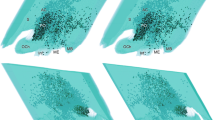Abstract
We have previously described a daily rhythm in thyrotropin releasing hormone (TRH) and TRH mRNA in the rat hypothalamus. To determine whether TRH release fluctuates in a diurnal manner, we have measured basal and potassium stimulated release from hypothalamic slices, and compared it to release from olfactory bulb slices, during the diurnal cycle. Basal TRH release was higher at 7:00 h than at any other time (1:00, 13:00 or 19:00 h) in either hypothalamus or olfactory bulb. The ratio of stimulated over basal release was higher in the hypothalamus at 19:00 h, when TRH content was highest. Potassium stimulated TRH release from olfactory bulb was not different from basal release at any time. TRH release fluctuations were not due to a rhythm of extracellular inactivation: the activity of pyroglutamyl aminopeptidase II, an ectoenzyme responsible for TRH inactivation, was constant throughout the cycle. Our data demonstrate that diurnal variations of TRH release occur in vitro and that the enhanced responsiveness to potassium stimulation in hypothalamus is correlated with increased levels of peptide.
Similar content being viewed by others
References
Levine, J. E., and Ramirez, V. D. 1989. Measurement of neuropeptide release: in vitro and in vivo procedures. Pages 163–192.in Conn, P. M. (ed.) Neuroendocrine peptide methodology. Academic Press, Inc., San Diego.
Kendrick, K. M. 1989. Use of microdialysis in neuroendocrinology. Pages 229–252,in Conn, P. M. (ed.) Neuroendocrine peptide methodology. Academic Press, Inc., San Diego.
Robbins, R., and Reichlin, S. 1982. In vitro systems for the study of secretion and synthesis of hypothalamic peptides. Pages 111–135.in Muller, E. E. and MacLeod, R. M. (eds.) Neuroendocrine perspectives, vol. 1. Elseviet Biomedical Press, Amsterdam.
Drouva, S. V., Laplante, E. and Kordon, C. 1985. Progesterone-induced LHRH release in vitro is an estrogen- as well as Ca2+-and calmodulin-dependent secretory process. Neuroendocrinology. 40:325–331.
Levine, J. E., and Ramirez, V. D. 1980. In vivo release of luteinizing hormone-releasing hormone estimated with push-pull cannulae from the mediobasal hypothalami of ovariectomized, steroid-primed rats. Endocrinology. 107:1782–1790.
Ramirez, V. D., Dluzen, D., and Lin, D. 1980. Progesterone administration in vivo, stimulates release of luteinizing hormone-releasing hormone in vitro. Science. 208:1037–1039.
Lechan, R. M., and Toni, R. 1992. Thyrotropin releasing hormone neuronal systems in the central nervous system. Pages 279–330.in Nemeroff, C. B. (ed.), Neuroendocrinology, CRC Press, Boca Raton.
Rondeel, J. M. M., De Greef, W. J., Klootwijk, W., and Visser, T. J. 1992. Effects of hypothyroidism on hypothalamic release of thyrotropin releasing hormone in rats. Endocrinology. 130:651–656.
Arancibia, S., Tapia-Arancibia, L., Assenmacher, I., and Astier, H. 1983. Direct evidence of short-term cold-induced TRH release in the median eminence of unanesthetized rats. Neuroendocrinology. 37:225–228.
De Greef, W. J., and Visser, T. J. 1981. Evidence for the involvement of hypothalamic dopamine and thyrotropin releasing hormone in suckling-induced release of prolactin. Journal of Endocrinology. 91:213–223.
Segerson, T. P., Kauer, J., Wolfe, H. C., Mobtaker, H., Wu, P., Jackson, I. M. D., and Lechan, R. M. 1987. Thyroid hormone regulates TRH biosynthesis in the paraventricular nucleus of the rat hypothalamus. Science. 238:78–80.
Uribe, R. M., Redondo, J. L., Charli, J. L., and Joseph-Bravo, P. 1983. Suckling and cold stress rapidly and transiently increase TRH mRNA in the paraventricular nucleus. Neuroendocrinology. 58:140–145.
Covarrubias, L., Uribe, R. M., Méndez, M., Charli, J. L., and Joseph-Bravo, P. 1988. Neuronal TRH synthesis: developmental and circadian TRH mRNA levels. Biochemical Biophysical Research Communications. 151:615–622.
Millington, W. R., Blum, M., Knight, R., Mueller, G. P., Roberts, J. L., and O'Donohue, T. L. 1986. A diurnal rhythm in proopiomelanocortin messenger ribonucleic acid that varies concomitantly with the content and secretion of β-endorphin in the intermediate lobe of the rat pituitary. Endocrinology. 118:829–834.
Watts, A. G., and Swanson, L. W. 1989. Diurnal variations in the content of preprocorticotropin-releasing hormone messenger ribonucleic acid in the hypothalamic paraventricular nucleus of rats of both sexes as measured by in situ hybridization. Endocrinology. 125:1734–1738.
Ulh, G. R., and Reppert, S. M. 1986. Suprachiasmatic nucleus vasopressin messenger RNA: circadian variation in normal and Brattelboro rats. Science. 232:390–393.
Méndez, M., Joseph-Bravo, P., Cisneros, M., Vargas, M. A., and Charli, J. L. 1987. Regional distribution of in vitro release of thyrotropin releasing hormone in rat brain. Peptides. 8:291–298.
Charli, J. L., Cruz, C., Vargas, M. A., and Joseph-Bravo, P. 1988. The narrow specificity pyroglutamate amino peptidase degrading TRH in rat brain is an ectoenzyme. Neurochemistry International. 13:237–242.
Charli, J. L., Méndez, M., Vargas, M. A., Cisneros, M., Assai, M., Joseph-Bravo, P., and Wilk, S. 1989. Pyroglutamyl peptidase II inhibition specifically increases recovery of TRH released from rat brain slices. Neuropeptides. 14:191–196.
Vargas, M. A., Méndez, M., Cisneros, M., Joseph-Bravo, P., and Charli, J. L. 1987. Regional distribution of the membrane bound pyroglutamate aminopeptidase degrading thyrotropin releasing hormone in rat brain. Neuroscience Letters. 79:311–314.
Tapia-Arancibia, L., and Astier, H. 1983. Opiate inhibition of K+-induced TRH release from superfused mediobasal hypothalami in rats. Neuroendocrinology. 37:166–168.
Tapia-Arancibia, L., Arancibia, S., and Astier, H. 1984. K+-induced thyrotropin-releasing hromone release from superfused mediobasal hypothalami in rat. Inhibition by somatostatin. Neuroscience Letters. 45:57–52.
Burns, G., Brown, B. L., and Dobson, P. R. M. 1988. Diurnal variation in the effect of potassium depolarization on vasoactive intestinal polypeptide release from rat hypothalamus: a possible role for adrenaline. Journal of Endocrinology. 116:335–341.
Author information
Authors and Affiliations
Rights and permissions
About this article
Cite this article
Covarrubias, L., Redondo, J.L., Vargas, M.A. et al. In vitro TRH release from hypothalamus slices varies during the diurnal cycle. Neurochem Res 19, 845–850 (1994). https://doi.org/10.1007/BF00967454
Accepted:
Issue Date:
DOI: https://doi.org/10.1007/BF00967454




